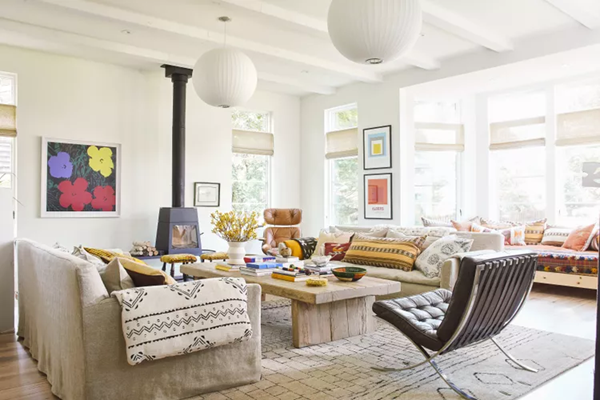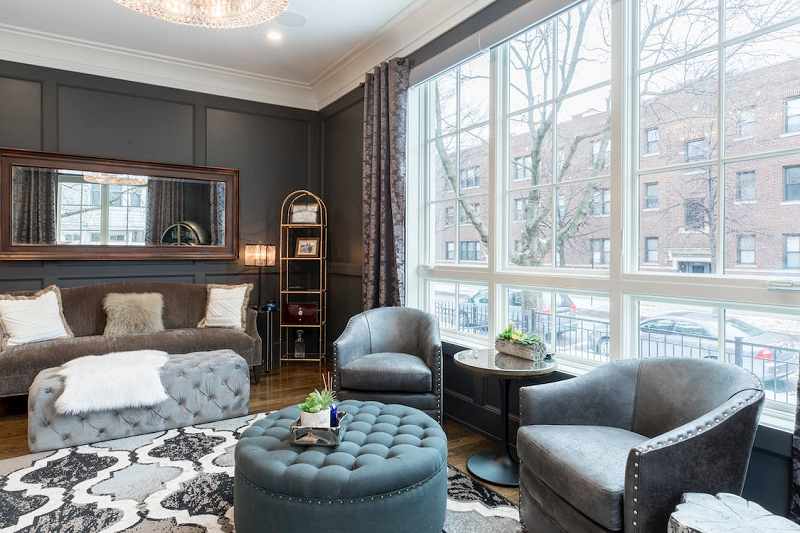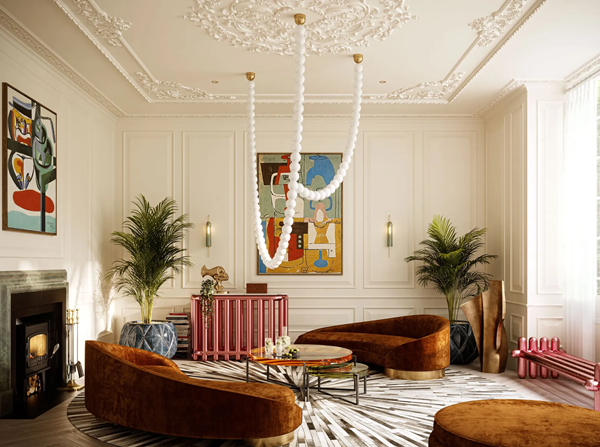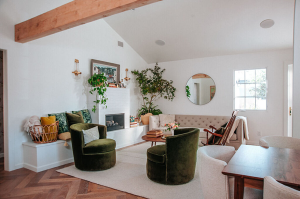Imagine stepping into a world where every room in your home is a reflection of your unique style and personality. Picture a space where the walls come alive with colors that resonate with you, your family, and the spirit of your house. This transformation begins with one key question: “How to choose paint colors?”
Selecting the perfect paint colors for your entire house isn’t just about aesthetics; it’s about creating an environment where you feel at home, energized, and at peace. It’s an art, a science, and an expression of your individuality all rolled into one.

In this post I’ll unravel the secrets on how to choose paint colors and the right hues but also sprinkle in some real-life stories to illustrate the power of paint.
Meet Sarah, a young homeowner who once stood in the middle of her new house, completely overwhelmed by the blank canvas of white walls. With a dream to turn her house into a cozy retreat, she set out on a quest to find the perfect colors that would bring warmth and character to every room.
And then there’s John, a DIY enthusiast with a penchant for experimenting. He dared to mix and match unexpected shades, turning his home into a vibrant masterpiece that never fails to impress guests.
In this blog, we’ll draw inspiration from Sarah and John’s journeys, among others, to show you how selecting paint colors can be a delightful adventure. But before we dive into the real-life stories and expert tips, let’s explore why paint color choices matter and how they can transform your living space into something truly extraordinary. So, grab your color palette, and let’s get started!
The Significance of Paint Colors

How to Set the Mood
Let’s meet Emily and Daniel, a couple who lives in a cozy cottage nestled in the countryside. Their story begins with a simple choice of paint color that would set the tone for their entire home. Emily, with an eye for sophistication, yearned for a calm and serene atmosphere. Daniel, on the other hand, was all about vibrancy and energy.
The battle of tastes played out on their living room walls. Emily envisioned a soft, muted blue that exuded tranquility, while Daniel prefer a fiery red that radiated excitement. After much debate, they compromised on a shade of lavender, which surprisingly turned out to be the perfect balance. This shade created an ambiance of peaceful serenity with a hint of liveliness.
The lesson here? Paint colors have the incredible power to set the mood in a room. Blues and greens tend to promote relaxation, while reds and yellows bring in warmth and energy. By understanding the psychological impact of colors, you can create spaces that resonate with the emotions and vibes you desire.
How Color Impacts Interior Design
Let’s hop over to a bustling city apartment where Lily, an interior designer, was tasked with revamping a client’s living space. The apartment had beautiful architectural details, but it was marred by a hodgepodge of paint colors that clashed mercilessly.
Lily knew that to truly highlight the apartment’s charm, a unified color scheme was essential. She opted for a neutral, creamy beige that served as the backdrop to showcase the stunning architectural features. With this subtle canvas, she added pops of color through carefully selected furniture and decor, creating a harmonious and visually appealing interior.
This real-life example showcases how paint colors play a pivotal role in interior design. They can accentuate architectural elements, make spaces feel larger or cozier, and tie together the overall aesthetic of a room. The right paint color acts as the canvas upon which your design masterpiece is crafted.
In the next section, we’ll dive deeper into the practical aspects of choosing paint colors for your home. From considering natural light to your personal preferences, I’ll equip you with the tools to make informed decisions that will transform your living spaces. So, get ready to turn your home into a masterpiece!
“If you are looking for a way to style your space with wall art without breaking your piggy bank, then I recommend reading “10 Surprising Benefits of Printable Wall Art”
Factors to Consider When Choosing Paint Colors

Natural Light and Room Size
In a quaint suburban neighborhood, Sarah found herself standing in her dream home’s living room. It was bathed in glorious sunlight, thanks to the large windows that stretched from floor to ceiling. Sarah was thrilled but also perplexed. She knew that natural light could significantly affect paint color appearance.
After some research, Sarah learned that rooms flooded with natural light could handle a wider range of colors. She decided to go with a soft, pale gray for her sun-soaked living room. The result? The room felt even more spacious, with the gray acting as a blank canvas that allowed her furniture and decor to shine.
Now, consider a different scenario. Mark, a friend of Sarah’s, lived in a cozy apartment with minimal natural light. He wanted to make his space feel brighter and more open. After consulting with an interior designer, he chose a crisp, clean white for his walls. This choice maximized the available light, making the apartment feel airy and inviting.
The key takeaway here is that natural light and room size should be key considerations when selecting paint colors. Understanding how these factors interact with color can help you create the perfect atmosphere in any space, whether it’s bathed in sunlight or in need of a brightness boost.
Architectural Style
In the heart of a historic district, there stood a charming Victorian-era house, owned by a couple, Lisa and Michael. They were determined to honor the architecture of their home while infusing it with a modern touch.
Lisa and Michael knew that the wrong paint colors could detract from the house’s timeless beauty. They researched and found that soft, pastel hues like pale yellow and mint green would complement the Victorian era’s ornate details. These colors added a touch of nostalgia while allowing them to introduce contemporary furnishings.
Across town, a different story was unfolding. David, a proud owner of a sleek and modern loft, embraced the minimalist aesthetic. His loft featured clean lines, exposed concrete walls, and industrial finishes. To enhance the loft’s edgy vibe, he chose a palette of cool grays and blacks. These colors accentuated the loft’s architectural features and created a cohesive, urban atmosphere.
These stories illustrate how architectural style plays a pivotal role in paint color choices. By selecting colors that harmonize with your home’s architectural elements, you can amplify its character and make a design statement that truly stands out.
Personal Preferences
Let’s meet Emma, a free-spirited artist living in a charming cottage by the sea. Her home was an eclectic blend of colors and patterns, a true reflection of her vibrant personality. Emma’s approach to choosing paint colors was a testament to the power of personal preferences.
Emma advised, “Your home should be an extension of your personality. Don’t be afraid to embrace colors that resonate with you.” She painted her kitchen a cheerful turquoise and her bedroom a soothing lavender, creating a space that felt uniquely hers.
“Your home should be an extension of your personality. Don’t be afraid to embrace colors that resonate with you.”
Emma
On the other hand, Thomas, a software engineer, preferred a more minimalistic and serene environment. His calm and clutter-free home boasted a palette of soft neutrals and earthy tones. These colors provided a sense of tranquility, allowing him to unwind after long days at work.
Your personal preferences are the compass that guides your paint color choices. Your home should reflect who you are, what you love, and how you want to feel when you walk through the door. In the end, the best color for your space is the one that makes you feel most at home.
“Gather inspiration from magazines, Pinterest boards, and even nature. Pay attention to colors you love in your clothes, artwork, and favorite spaces. This will help you narrow down your options and find a palette that resonates with you.”
Emily Henderson, decorator blogger
As we move forward, we’ll explore practical steps to choosing paint colors, including understanding the color wheel, exploring Joanna Gaines’ favorite shades, and mastering the art of color coordination. Get ready to bring your vision to life, one brushstroke at a time!
Practical Steps to Choosing Paint Colors

Color Wheel and Basics
Imagine you’re standing in an art studio surrounded by an array of vibrant paint tubes. You’re about to create a masterpiece, but where do you start? The color wheel, my friend, is your trusty guide.
The color wheel is like a treasure map for choosing paint colors. It’s divided into primary, secondary, and tertiary colors, all harmoniously arranged. Understanding the basics of the color wheel will empower you to make informed choices.
Primary Colors: Red, blue, and yellow are the building blocks. You can mix them to create a wide range of colors.
Secondary Colors: These are formed by mixing two primary colors. Think green (blue + yellow), orange (red + yellow), and purple (blue + red).
Tertiary Colors: These are the subtle variations between primary and secondary colors. Examples include red-orange and yellow-green.
Now, let’s talk color schemes. Whether you want a monochromatic palette (variations of a single color), complementary colors (opposites on the wheel like blue and orange), or analogous colors (neighboring colors like blue and green), the color wheel has your back.
Understanding these color basics will help you craft a visually pleasing and balanced color scheme for your entire house.

Coordinating Colors in Your House
Picture this: You’re walking through your home, and each room flows seamlessly into the next, creating a cohesive and harmonious atmosphere. Achieving this level of color coordination is like composing a symphony of shades.
One technique to achieve color harmony is through a concept called “color flow.” This means choosing a base color that runs through different areas of your home. It could be a neutral like beige, gray, or white. Then, you can introduce complementary colors or variations of the base color in each room, creating a natural transition from one space to another.
“Think of your whole house as one connected space, not a series of isolated rooms. Choose a color palette that flows seamlessly from room to room, creating a sense of cohesion and harmony. This doesn’t mean everything has to be the same color, but choose colors that complement each other and tie the overall look together.”
Sarah Richardson, TV host and interior designer.
Imagine you have a base color of soft beige in your living room. You can extend this color by adding beige-toned decor items like cushions, rugs, or curtains. As you move into the dining room, you might introduce a deeper shade of beige or a complementary color like muted green, maintaining a sense of connection.
Creating color harmony doesn’t mean every room has to be identical, but it ensures there’s a pleasing visual flow as you journey through your home.
In our next section, we’ll delve into practical tools and resources that will make the paint color selection process even more exciting and foolproof. From paint color apps to expert consultations, we’ll equip you with the knowledge and tools you need to paint your world with confidence.
Tools and Resources for Choosing Paint Colors

Paint Color Apps
Imagine having a magic wand that allows you to visualize paint colors in your home without lifting a brush. Well, it’s not exactly magic, but it’s pretty close—paint color apps can make it happen.
These user-friendly apps are like virtual paint palettes. You can snap a photo of your room and experiment with different colors digitally. Not only do they help you see how a color will look in your space, but they also provide valuable information on color schemes and shades.
Some Popular Paint Color Apps Include:
- Sherwin-Williams ColorSnap® Visualizer: This app lets you try out Sherwin-Williams’ extensive range of colors in your room, offering suggestions and combinations.
- Behr ColorSmart: Behr’s app provides inspiration galleries, color matching tools, and a virtual room painter to bring your ideas to life.
- Benjamin Moore Color Portfolio: With Benjamin Moore’s app, you can explore their vast color collection and find the perfect shade for your project.
- Home Harmony by Valspar: Valspar’s app offers color matching and coordination features, making it easy to find the right colors for your home.
Using these apps can be a game-changer in your paint color selection journey. It takes the guesswork out of the equation and allows you to experiment until you discover the perfect color palette for your space.
Consultation with Experts
Sometimes, you need a guiding hand to navigate the colorful world of paint selection. That’s where the experts come in. Interior designers and color consultants are your secret weapons for achieving paint perfection.
Imagine meeting with a seasoned interior designer who not only understands your style but also has an in-depth knowledge of color psychology and trends. They can assess your space, suggest color palettes that align with your vision, and recommend finishes that suit your lifestyle.
The beauty of working with experts is that they can tailor their advice to your unique needs. Whether you want a cozy, rustic vibe or a chic, contemporary look, they can help you find the colors that make your dream a reality.
Don’t hesitate to reach out to professionals in your area. Their expertise can save you time, money, and the headache of second-guessing your choices.
Now, as you move forward on selecting your paint color, remember that these tools and resources are your allies. Whether you choose the digital wizardry of paint color apps or the wisdom of seasoned experts, they all exist to make your vision come to life with confidence.
In the final section, I’ll address some of the burning questions you may have about choosing paint colors. From the basics like “How do I choose a good paint color?” to the practicality of “Is there an app to choose paint colors?” We’ll leave no color stone unturned.
How Do I Choose a Good Paint Color?

How to choose paint colors is all about understanding your space and your preferences. Start by considering the mood you want to create. Are you aiming for relaxation, energy, or something in between?
Here’s a step-by-step guide to help you choose a good paint color:
- Assess Natural Light: Evaluate how much natural light the room receives. More light allows for a wider range of colors, while darker rooms may benefit from lighter shades.
- Consider Room Size: Smaller rooms can feel more spacious with light, cool colors, while larger rooms can handle bolder, warmer hues.
- Reflect on Your Style: Think about your personal style and the atmosphere you want to create. Do you prefer traditional, modern, or eclectic design?
- Sample Paint Colors: Don’t skip the paint samples. Purchase small paint samples and test them on your walls to see how they look in different lighting conditions.
- Consult a Color Wheel: Refer to the color wheel to understand color relationships and choose complementary or analogous colors for a cohesive look.
- Seek Inspiration: Gather inspiration from magazines, home decor websites, or even your favorite TV shows to find colors that resonate with you.
“Never make a final decision based on a tiny paint chip! Paint large swatches on your walls in different lighting conditions to see how the color actually looks in your space. Don’t be afraid to experiment and adjust your palette until you find the perfect fit.”
Abigail Ahern, renowned interior designer
Remember, choosing a good paint color is a personal journey. Trust your instincts, experiment with samples, and don’t be afraid to go bold or stick with neutrals—it’s your space, and it should reflect your personality.
How Do You Coordinate Colors in a House?

Coordinating colors in a house is like composing a symphony. Here are some key tips to achieve color harmony:
- Choose a Base Color: Start with a neutral base color that runs through different areas of your home. This creates a consistent backdrop.
- Use Variations of the Base: In each room, introduce shades or complementary colors that tie back to the base, creating a sense of unity.
- Transition Gradually: When transitioning from one room to another, consider using transitional elements like hallway decor or rugs to create a gradual shift in color.
- Balance Warm and Cool Tones: Maintain a balance between warm and cool colors to avoid abrupt transitions.
- Experiment with Accents: Use accent colors in decor items like pillows, artwork, and furniture to add pops of color without overwhelming the space.
By coordinating colors effectively, you can create a sense of flow and visual harmony throughout your home, making it feel like a well-composed masterpiece.
Most Popular Post:
10 Surprising Benefits of Printable Wall Art
15 Must-Have Accessories For Styling A Coffee Table
How to Choose the Perfect Interior Color Scheme for Your Home
Expert Guide On How To Buy A Rug For Each Room
Conclusion
In interior design, the process of how to choose paint colors cannot be overstated. It’s the brushstroke that sets the mood, the canvas that tells your story, and the thread that weaves your home’s unique tapestry. Our colorful journey through the art of choosing paint colors has illuminated the path to creating spaces that resonate with your soul.
From setting the mood with colors that reflect your emotions to understanding the impact of architectural style and harnessing the magic of personal preferences, you’ve discovered the keys to paint color selection.
You’ve explored the color wheel’s secrets, drawn inspiration from Joanna Gaines’ favorites, and mastered the art of color coordination. Armed with practical tools like paint color apps and the wisdom of experts, you’re ready to transform your spaces into masterpieces of design.
Whether you’re starting with a blank canvas, revamping an existing space, or simply seeking a change, remember that choosing paint colors is an artistic journey. It’s an opportunity to express yourself, create a harmonious atmosphere, and make your home uniquely yours.
So, pick up that paintbrush with confidence, knowing that each stroke brings you closer to the vision you have for your space. As you watch your rooms come to life with carefully chosen colors, you’ll experience the transformative magic of paint—a magic that turns houses into homes and walls into stories.
As we conclude this post, I leave you with one final piece of advice: Let your imagination run wild, embrace your individuality, and paint your space with the colors of your dreams. Your home is your canvas—now go and make it a masterpiece. Happy painting!
Frequently Asked Questions (FAQs)
Q1: How Do I Choose the Right Paint Color for My Home?
Choosing the right paint color for your home involves considering factors such as natural light, room size, your personal style, and the mood you want to create. It’s essential to sample paint colors on your walls and consult a color wheel for guidance. Seeking inspiration from magazines, home decor websites, or experts can also help you make an informed choice.
Q2: Should My Entire House Be Painted the Same Color?
There’s no strict rule, but painting your entire house the same color can create a cohesive and unified look, especially in open-concept homes. However, it’s not a requirement. Many homeowners choose different colors for various rooms to express their style and create diverse atmospheres.
Q3: What Is the Best Color to Paint an Entire House?
The best color to paint an entire house depends on your preferences and the atmosphere you want to create. Neutrals like soft grays, beige, or whites are versatile choices that work well throughout the home. These colors provide a timeless backdrop that complements various styles and decor.
Q4: How Many Paint Colors Should I Use in My House?
The number of paint colors in your house depends on personal taste and architectural design. Some opt for a consistent color palette using variations of the same color, while others choose distinct colors for each room. The goal is to strike a balance that suits your style while maintaining harmony and flow between spaces.
Q5: Is There an App to Help Choose Paint Colors?
Yes, there are several paint color apps available that allow you to visualize different paint colors in your space. These apps often provide virtual try-on features, color coordination suggestions, and inspiration galleries, making the selection process easier and more convenient.
Q6: Can I Consult with an Expert for Paint Color Advice?
Absolutely! Consulting with an interior designer or color consultant can be invaluable. These experts can assess your space, understand your style, and recommend color palettes that align with your vision. Their expertise can save you time, money, and ensure you achieve the desired look.
Q7: How Do I Coordinate Colors in Different Rooms of My House?
Coordinating colors in different rooms involves choosing a base color that runs through your home and using variations or complementary colors in each room. Transitional elements like decor items or rugs can create gradual shifts in color, maintaining visual harmony as you move from one space to another.
These FAQs are designed to address common questions about choosing paint colors for your home. If you have any more inquiries or need specific guidance, feel free to reach out to experts or use paint color apps to assist you in your decision-making process. Happy painting!
CATCH THE LATEST IN HOME DECOR TRENDS:

Steal These 15 Expert-Approved Decorating Secrets

How To Accessories Your Living Room

Small Space? 10 Ways To Make A Room Appear Bigger

Make Your space Look Expensive
GET CAUGHT UP ON ALL THE INSPIRING DECOR TIPS:

18 Fresh Decorating Ideas To Update Your Fireplace

How To Create An Art Gallery Wall
